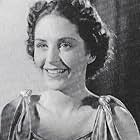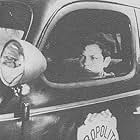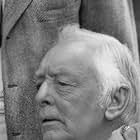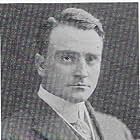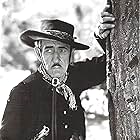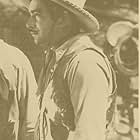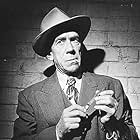Aggiungi una trama nella tua linguaA young radio cop and a beautiful girl try to stop an international criminal gang from getting their hands on the formula for a new bulletproof steel.A young radio cop and a beautiful girl try to stop an international criminal gang from getting their hands on the formula for a new bulletproof steel.A young radio cop and a beautiful girl try to stop an international criminal gang from getting their hands on the formula for a new bulletproof steel.
Kay Hughes
- Molly Selkirk
- (as Catherine Hughes)
C. Montague Shaw
- Mr. Wellington
- (as Montague Shaw)
Ernie Adams
- Hobo
- (non citato nei titoli originali)
Hooper Atchley
- Casey
- (non citato nei titoli originali)
Trama
Lo sapevi?
- QuizRichard Cramer is the voice of the police radio dispatcher.
- BlooperA German Shepard plays Irish. According to the original comics, Irish was a Irish Setter.
- Curiosità sui creditiChapter forewords are depicted in cartoon panels.
- ConnessioniEdited into Enemy Agent (1940)
- Colonne sonoreLes Preludes
Composed by Franz Liszt
Recensione in evidenza
Like any other business, the various Newspaper Publishers were constantly on the lookout for ways to increase their appeal to the public. Hence they would experience an almost immediate rise in Daily and Sunday circulation, which, of course, leads to increased positive Ca$h Flow and Profit$.
One such feature of great importance in those "Good Old Days" was the Syndicated Comic Strip.(Syndicated Comic Strip is a feature that appears in multi newspapers simultaneously throughout the USA and even the World. The fee for a particular feature, say Al Capp's L'IL ABNER, was calculated by the circulation of said periodical.)
The success of Chester Gould's DICK TRACY (Chicago Tribune-N.Y. News Syndicate) in 1931 left a perceived "need" in the other papers for a serious, strip with the theme of Law Enforcement at its core. When a local feature called PINKERTON, JUNIOR appeared in Hearst's Boston Record, it was immediately drafted by Hearst's King Features Syndicate for multiple sales to noted journals of the noble "Fourth Estate".* The title of "PINKERTON JR"(named so for the main Juvenile character, 'Pinky' for short), was found to to be unacceptable. So, following a "quickie legal Name Change" to the more 'adult' sounding RADIO PATROL the strip was made available for World Wide distribution. The strip was creation of 2 Boston Record staffers. Eddie Sullivan(a veteran Polie Beat Reporter) and Charles Schmidt(Staff Cartoonist) were the co-creators.
Whereas DICK TRACY has been called "the best written, but worst drawn action comic strip", RADIO PATROL could claim top honors in both the written word and in the visual aspects of story telling.
The Strip had both Daily(1933-55) and Sunday(1934-46) versions. It was very life-like in characterization and storyline, as well as illustration of artwork in a style that was somewhat similar to Alex Raymond's FLASH GORDON. It was dedicated to the "exciting adventures"(?)encountered by the men of the 'Prowler' or 'Beat Car' in their day to day work shifts(aka 'Watches'); and their use of that modern marvel, the 2 Way Radio!!** The setting of the strip, whether stated or implied, was Boston, with Boston uniformed Police, Boston & other New England locations. The main characters included "Pinky"(Pinkerton, Jr.), his Irish Setter Dog appropriately named "Irish", Sgt. Pat O'Hara, Officer "Stitterin' Sam" and Policewoman Molly.
The 1937 serial did an "A-OK" job of casting. Versatile Grant Withers (Sgt. Pat O'Hara), Adrian Morris(Officer "Stutterin'"Sam Maloney), Kay Hughes(Molly) and young Mickey Rentschler(Pinkerton "Pinky" Adams) all rounded out the main 2 legged characters. In a case of obvious miscasting, 'Silver Wolf' a German Shepherd portrays "Irish", an Irish Setter. (Okay, it's only a minor fop-ah! All is forgiven, Universal Pictures.) The story re-introduces the characters to the public, only this time it's in the celluloid rather than the printed form. Once this is done, the rest of the story involves a flexible, bullet-proof steel-alloy, invented by Pinky's Father! For 12 Chapters,we have espionage(of both governmental & industrial varieties) , killings, robberies, we have chases and near death traps for our heroes.
The Serial,much like the newspaper strip,had the Police characters splitting their work time between uniformed and plainclothes assignments. The intertwining sub-plots all made good use of the girl, the kid and his dog.(Just like in real life, yes! No?) There was the ever present ensemble of fine Universal Pictures' Character Actors clearly in evidence throughout. The list reads like a who's who of familiar faces/obscure names of Hollywood. We have: C. Montague Shaw, Frank Lackteen, Gordon Hart, Harry Davenport, Jack Mulhall, Stanley Kramer, Dick Kramer, etc., etc., etc.,.................
The music is all prime Universal Pictures', culled from both formerly used Film Themes and from incidental music and musical queues, which were all too familiar to the 1930's movie goers. About the most amusing use of a particular theme comes in several of the chapters. In several scenes in the mysterious Egyptian operative, Mr. Tahata(Frank Lackteen). In the story, Tahata is shown as going to "the Egyptian Section of Town". It is portrayed as looking like a dessert oasis. And to top it off, there is a Middle Eastern theme playing, containing the distinct sounds of a flute & those tiny finger ring cymbals.
Definitely worth the investment of 3 1/2 to 4 hours.
* The Fourth Estate; an archaic term for the Press!
** The use of the 2 way radio was an astonishing development of technology in our arsenal of crime fighting tools. For a short period before their implementation, calls of the Chicago Police were broadcast over WGN Radio, 720 AM! The information would break right in on the scheduled program. Of course, it would have to be of a serious nature, not any of these "Dog Sh*t on the lawn" or the like.
One such feature of great importance in those "Good Old Days" was the Syndicated Comic Strip.(Syndicated Comic Strip is a feature that appears in multi newspapers simultaneously throughout the USA and even the World. The fee for a particular feature, say Al Capp's L'IL ABNER, was calculated by the circulation of said periodical.)
The success of Chester Gould's DICK TRACY (Chicago Tribune-N.Y. News Syndicate) in 1931 left a perceived "need" in the other papers for a serious, strip with the theme of Law Enforcement at its core. When a local feature called PINKERTON, JUNIOR appeared in Hearst's Boston Record, it was immediately drafted by Hearst's King Features Syndicate for multiple sales to noted journals of the noble "Fourth Estate".* The title of "PINKERTON JR"(named so for the main Juvenile character, 'Pinky' for short), was found to to be unacceptable. So, following a "quickie legal Name Change" to the more 'adult' sounding RADIO PATROL the strip was made available for World Wide distribution. The strip was creation of 2 Boston Record staffers. Eddie Sullivan(a veteran Polie Beat Reporter) and Charles Schmidt(Staff Cartoonist) were the co-creators.
Whereas DICK TRACY has been called "the best written, but worst drawn action comic strip", RADIO PATROL could claim top honors in both the written word and in the visual aspects of story telling.
The Strip had both Daily(1933-55) and Sunday(1934-46) versions. It was very life-like in characterization and storyline, as well as illustration of artwork in a style that was somewhat similar to Alex Raymond's FLASH GORDON. It was dedicated to the "exciting adventures"(?)encountered by the men of the 'Prowler' or 'Beat Car' in their day to day work shifts(aka 'Watches'); and their use of that modern marvel, the 2 Way Radio!!** The setting of the strip, whether stated or implied, was Boston, with Boston uniformed Police, Boston & other New England locations. The main characters included "Pinky"(Pinkerton, Jr.), his Irish Setter Dog appropriately named "Irish", Sgt. Pat O'Hara, Officer "Stitterin' Sam" and Policewoman Molly.
The 1937 serial did an "A-OK" job of casting. Versatile Grant Withers (Sgt. Pat O'Hara), Adrian Morris(Officer "Stutterin'"Sam Maloney), Kay Hughes(Molly) and young Mickey Rentschler(Pinkerton "Pinky" Adams) all rounded out the main 2 legged characters. In a case of obvious miscasting, 'Silver Wolf' a German Shepherd portrays "Irish", an Irish Setter. (Okay, it's only a minor fop-ah! All is forgiven, Universal Pictures.) The story re-introduces the characters to the public, only this time it's in the celluloid rather than the printed form. Once this is done, the rest of the story involves a flexible, bullet-proof steel-alloy, invented by Pinky's Father! For 12 Chapters,we have espionage(of both governmental & industrial varieties) , killings, robberies, we have chases and near death traps for our heroes.
The Serial,much like the newspaper strip,had the Police characters splitting their work time between uniformed and plainclothes assignments. The intertwining sub-plots all made good use of the girl, the kid and his dog.(Just like in real life, yes! No?) There was the ever present ensemble of fine Universal Pictures' Character Actors clearly in evidence throughout. The list reads like a who's who of familiar faces/obscure names of Hollywood. We have: C. Montague Shaw, Frank Lackteen, Gordon Hart, Harry Davenport, Jack Mulhall, Stanley Kramer, Dick Kramer, etc., etc., etc.,.................
The music is all prime Universal Pictures', culled from both formerly used Film Themes and from incidental music and musical queues, which were all too familiar to the 1930's movie goers. About the most amusing use of a particular theme comes in several of the chapters. In several scenes in the mysterious Egyptian operative, Mr. Tahata(Frank Lackteen). In the story, Tahata is shown as going to "the Egyptian Section of Town". It is portrayed as looking like a dessert oasis. And to top it off, there is a Middle Eastern theme playing, containing the distinct sounds of a flute & those tiny finger ring cymbals.
Definitely worth the investment of 3 1/2 to 4 hours.
* The Fourth Estate; an archaic term for the Press!
** The use of the 2 way radio was an astonishing development of technology in our arsenal of crime fighting tools. For a short period before their implementation, calls of the Chicago Police were broadcast over WGN Radio, 720 AM! The information would break right in on the scheduled program. Of course, it would have to be of a serious nature, not any of these "Dog Sh*t on the lawn" or the like.
I più visti
Accedi per valutare e creare un elenco di titoli salvati per ottenere consigli personalizzati
Dettagli
- Data di uscita
- Paese di origine
- Lingua
- Celebre anche come
- Radio patrola
- Luoghi delle riprese
- Azienda produttrice
- Vedi altri crediti dell’azienda su IMDbPro
- Tempo di esecuzione4 ore 2 minuti
- Colore
- Mix di suoni
- Proporzioni
- 1.37 : 1
Contribuisci a questa pagina
Suggerisci una modifica o aggiungi i contenuti mancanti

Divario superiore
By what name was Radio Patrol (1937) officially released in Canada in English?
Rispondi





